Getting a cat used to wearing a collar and taking it for walks can be a challenge, as felines tend to feel restricted. However, with proper training and patience, it is possible to make this activity a comfortable and pleasurable experience for your pet.
One of the first steps to walking cats on a leash is choosing a suitable chest collar that is comfortable and safe . Consider your cat’s size and personality when making this choice.
Before taking your cat for a walk, it’s important to get him used to wearing a collar inside the house. Let him familiarize himself with the accessory by gradually using it for short periods of time. Over time, you can attach the leash and encourage the cat to walk around the house on the leash.
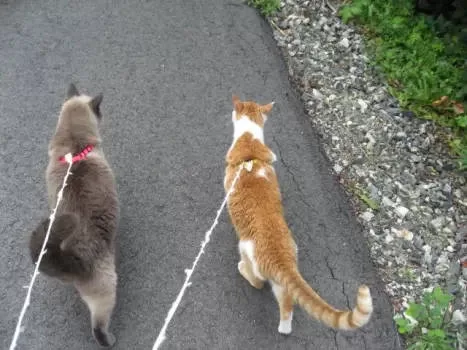
When it’s time for your first walk outside, take it slow. Allow the cat to explore the environment at its own pace, following its natural instinct. Offer rewards and praise to encourage your cat to feel more comfortable and confident during walks.
It is important to be patient throughout the process. Each cat has its own rhythm and style, and it is essential to respect them. Don’t force your cat to do something he’s not comfortable with, as this can cause stress and anxiety.
Furthermore, it is necessary to take some precautions during tours. Keep the cat close to you, preventing it from moving away or getting tangled up in obstacles. Make sure your dog is up to date with his vaccinations and make regular visits to the vet to ensure your pet’s health.
Main points to highlight:
- Choose a suitable chest collar for your cat;
- Get the cat used to wearing the collar inside the house;
- Encourage the cat to walk on a leash gradually;
- Allow the cat to explore the environment at its own pace;
- Offer rewards and praise during walks;
- Be patient and respect your cat’s rhythm;
- Take essential precautions during walks, such as keeping your cat close and ensuring its health.
Walking with cats: a challenge for the leash
Walking cats on a leash can be a challenging activity, as felines don’t usually like to feel restricted. However, it is possible to get your cat used to wearing a collar through training and patience.
It is important to choose a suitable chest collar for cats that is comfortable and safe . Before taking him outside, it is recommended to get the cat used to wearing the collar indoors, letting him get familiar with the accessory . After this step, the leash can be attached and the cat can be encouraged to walk around the house.
When taking him for a walk for the first time, it’s important to start slowly, allowing him to explore the environment at his own pace. It is essential to offer rewards and praise to encourage the cat. It’s important to remember that each cat has its own rhythm and style, so patience is essential. In addition, it is necessary to take some precautions, such as keeping the cat close, ensuring that it is up to date with its vaccinations and making regular visits to the veterinarian.
Choosing the Right Harness Collar for Your Cat
Walking cats on a leash can be a challenging activity, especially because felines don’t usually like to feel restricted. However, it is possible to get your cat used to wearing a collar through training and patience. An important step in this process is choosing the right chest collar for your cat, ensuring it is comfortable and safe .
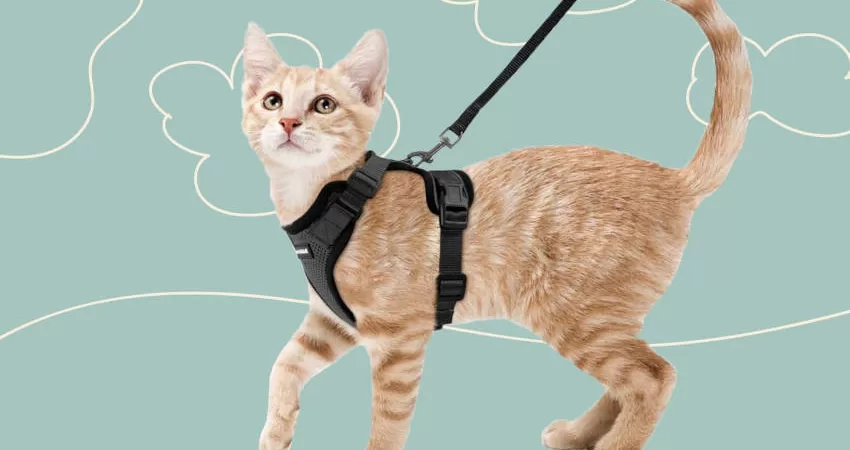
There are different types of collars available on the market, but for cats, a chest collar is generally the best option. It wraps around the cat’s body more securely and prevents neck discomfort that can occur with traditional neck collars.
When choosing a chest collar for your cat, take the animal’s size and personality into consideration. Make sure the collar is adjustable and has safety clasps to prevent your cat from escaping. Furthermore, check that the material is soft and resistant, to provide comfort and durability during your outings.
Comfortable and safe: the key to a good chest collar
| Cat Size | Chest Collar Size |
|---|---|
| Small (up to 3 kg) | PP (XXXS) |
| Medium (3 to 5 kg) | P (XXS) |
| Large (over 5 kg) | M (XS) |
Remember that every cat is unique and may have different preferences when it comes to collars. Therefore, it is recommended to observe your cat’s reaction after putting on the collar, making sure he is comfortable and safe. If the cat shows discomfort or tries to remove the collar, it is possible that the choice of size or type of clasp is not appropriate.
By choosing the right chest collar for your cat, you will be providing him with a more comfortable experience on walks. Remember that your cat’s well-being and safety are always a priority, so invest some time in choosing the right chest collar and enjoy pleasant moments outdoors with your feline!
Getting your cat used to the collar indoors
Walking cats on a leash can be a challenging activity, as felines don’t usually like to feel restricted. However, it is possible to get your cat used to wearing a collar through training and patience.
Before taking him outside, it is recommended to get the cat used to wearing the collar indoors, letting him get familiar with the accessory . Start by introducing the collar to the cat, allowing it to smell and explore it. Keep it nearby while he is relaxed and comfortable. Repeat this process a few times until he is familiar with the presence of the collar.
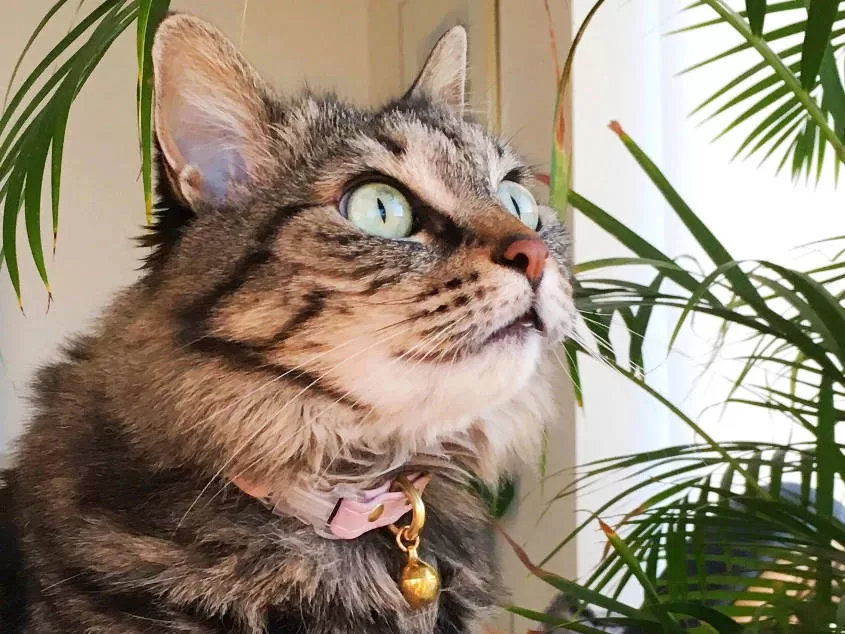
Then adjust the collar around the cat’s neck, but don’t tighten it too much. Let him walk around the house on a leash for a short period of time. During this time, observe the cat’s reaction and make sure he is feeling comfortable. If he is restless or stressed, remove the collar and try again later. Gradually increase the amount of time you wear the collar until your cat feels comfortable wearing it.
After the familiarization phase, it’s time to encourage your cat to walk on a leash indoors. Use a light, secure leash attached to the collar and hold it gently, allowing the cat to explore the surroundings of the house. Initially, he may be hesitant and prefer to hide, but with patience and encouragement, he will begin to walk and explore his surroundings .
When walking your cat, avoid pulling on the leash or forcing your cat to walk in a specific direction. Let him go at his own pace and discover the environment around him. Praise and reward him when he is moving and showing signs of comfort.
Remember that each cat has its own rhythm and style. Some may adapt quickly, while others may take longer. If your cat is very stressed or uncomfortable, go back and repeat the previous steps until your cat is ready to move on.
| Tips for getting your cat used to a collar indoors: |
|---|
| Introduce the collar gradually, letting the cat smell and explore it; |
| Adjust the collar around the cat’s neck, making sure it is not tight; |
| Let the cat walk around the house on a leash for short periods; |
| Gradually increase the time you wear the collar; |
| Encourage the cat to walk on a leash using a light and safe leash; |
| Allow the cat to explore the environment at its own pace; |
| Praise and reward the cat when it is moving and showing comfort; |
| Be patient and respect your cat’s time. |
By getting your cat used to a leash indoors, you will be preparing him for outdoor walks, where he can explore the outside environment while remaining safe and comfortable. Always remember to make sure your cat is up to date with its vaccinations and make regular visits to the vet to take care of its health during walks.
Encouraging your cat to walk on a leash
Walking cats on a leash can be a challenging activity, as felines generally don’t like to feel restricted. However, it is possible to get your cat used to wearing a collar through training and patience. The key to encouraging your cat to walk on a leash is letting him become familiar with the accessory and encouraging him to walk at his own pace.
Before taking your cat out for a walk for the first time, it’s important to get him used to wearing a collar indoors. Start by leaving the collar nearby, allowing him to become familiar with the scent and presence of the accessory. Then, attach the leash to the collar, but don’t hold it yet. Let your cat explore the house with the leash attached, encouraging him to walk and move freely.
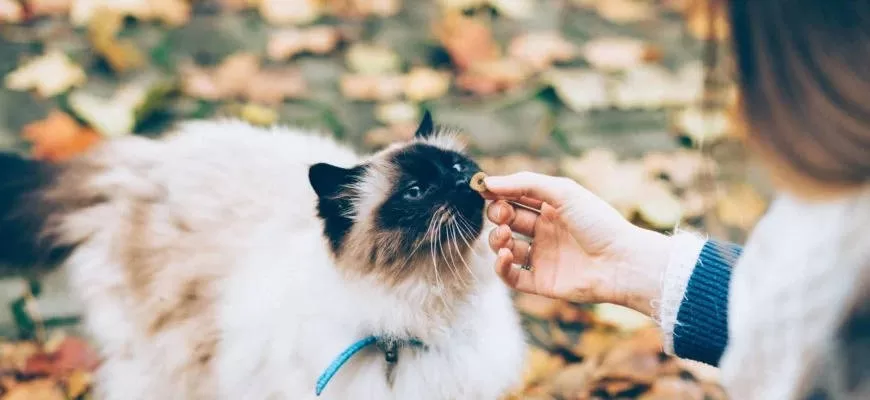
As your cat adapts to the leash, you can start holding it gently as he walks around the house. Remember to reward him with treats and praise when he is walking on a leash. Gradually, you can increase the duration and intensity of walks indoors, always respecting your cat’s rhythm.
Once you feel like your cat is comfortable wearing the collar and walking around the house, it’s time to take him for a walk outside. Start in a quiet, familiar environment, like your garden. Allow him to explore the environment at his own pace, without forcing him to walk beyond what he is comfortable with. Remember to praise and reward him during and after the walk, so that he associates the experience with something positive.
| Tips for encouraging your cat to walk on a leash |
|---|
| 1. Let your cat get familiar with the collar inside the house before going on walks. |
| 2 . Encourage him to walk around the house with the leash attached, rewarding him every time he walks. |
| 3. Gain your cat’s trust by gently holding the leash as he explores the house. |
| 4. Gradually increase the duration and intensity of indoor walks. |
| 5. When going for a walk outside, start in a familiar environment and allow him to explore at his own pace. |
Remember that each cat has its own rhythm and style, so patience and respect are key during training. Don’t force your cat to do something he isn’t comfortable with. With dedication and positive encouragement, you will be helping your cat feel more confident and comfortable on leash walks.
Your cat’s first walk outside
Walking cats on a leash can be a challenging activity, but with patience and proper technique, it is possible to make this experience enjoyable for the feline. After getting your cat used to wearing the collar indoors, it’s time to take him for his first walk outdoors.
To ensure your cat’s safety during the walk, it’s important to start slowly. Choose a familiar, quiet location, away from busy streets and intense stimuli. Allow your cat to explore the environment at its own pace, letting it lead the way. Remember to pay attention to your cat’s signs of discomfort or fear and always respect your cat’s pace.
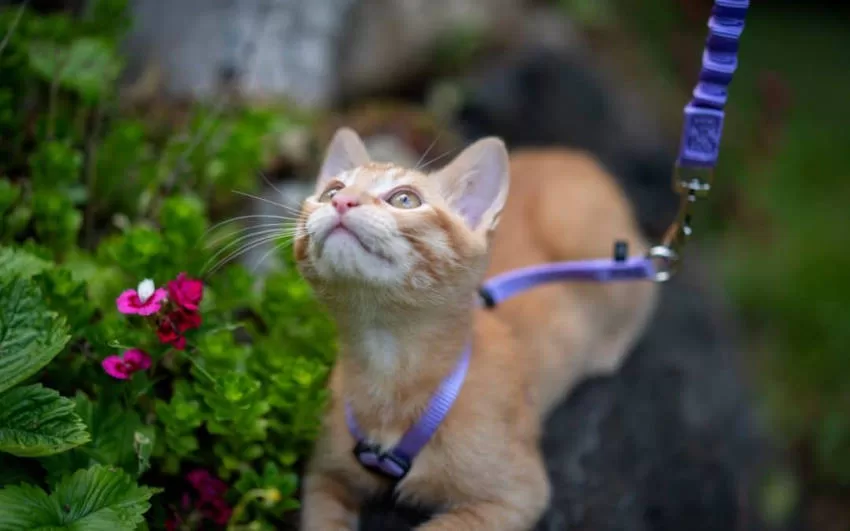
As your cat explores the environment, use the leash to keep your cat close to you. This helps create a sense of security for the cat and prevents it from getting lost or injured. Continue stimulating him with rewards and praise during the walk, reinforcing positive behavior.
| Tips for your first outing: |
|---|
| Approach the walkway calmly, so as not to scare your cat. |
| Allow your cat to explore the environment at its own pace. |
| Use the leash to keep him close to you and avoid possible escapes. |
| Offer your cat rewards and praise to encourage him. |
| Respect your cat’s pace and limits. |
Remember that the first trip outside can be a little scary for your cat, so it’s important to be patient and create a positive experience. Over time, your cat will become more confident and enjoy outdoor walks more and more.
Rewards and praise to encourage your cat
Walking cats on a leash can be a challenging activity, as felines don’t usually like to feel restricted. However, it is possible to get your cat used to wearing a collar through training and patience. It is important to choose a suitable chest collar for cats that is comfortable and safe.
Before taking him outside, it is recommended to get the cat used to wearing the collar indoors, letting him get familiar with the accessory. After this step, the leash can be attached and the cat can be encouraged to walk around the house. When taking him for a walk for the first time, it’s important to start slowly, allowing him to explore the environment at his own pace.
An effective strategy to encourage your cat to enjoy walking on a leash is to offer rewards and praise during and after walks. You can use special treats that he likes as a reward when he behaves well during the walk. Additionally, praise him with affection and kind words to reinforce his positive behavior.
Remember that each cat has its own rhythm and style, so patience is key. Respect your feline’s time and avoid forcing him to do something he is not comfortable with. With time and adequate stimulation, many cats become more confident and enjoy on-leash walks, creating a pleasant and enriching experience for both.
| Rewards for cats | Encourage tours |
|---|---|
| Offer special snacks during tours | This will associate the collar with something positive for the cat. |
| Praise him with affection and kind words | This will reinforce your positive behavior |
| Respect your cat’s time and rhythm | Each feline has its own adaptation process |
Patience: respecting your cat’s rhythm
Walking cats on a leash can be a challenging activity, as felines don’t usually like to feel restricted. However, it is possible to get your cat used to wearing a collar through training and patience. It is important to choose a suitable chest collar for cats that is comfortable and safe.
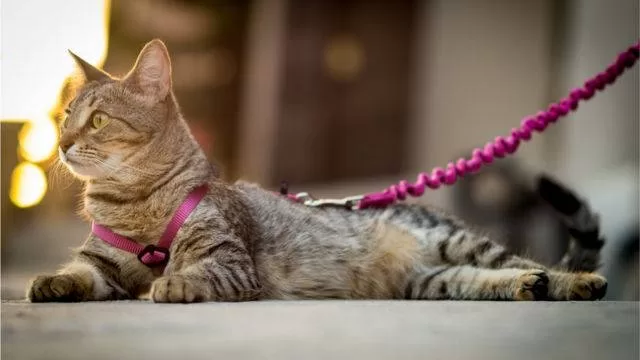
Before taking him outside, it is recommended to get the cat used to wearing the collar indoors, letting him get familiar with the accessory. After this step, the leash can be attached and the cat can be encouraged to walk around the house. When taking him for a walk for the first time, it’s important to start slowly, allowing him to explore the environment at his own pace.
It is essential to offer rewards and praise to encourage the cat. It’s important to remember that each cat has its own rhythm and style, so patience is essential. In addition, it is necessary to take some precautions, such as keeping the cat close, ensuring that it is up to date with its vaccinations and making regular visits to the veterinarian.
| Tips for getting your cat used to the collar: |
|---|
| 1. Choose a comfortable and safe chest collar. |
| 2. Let the cat become familiar with the collar indoors. |
| 3. Use rewards and praise to encourage the cat. |
| 4. Start walks slowly, respecting the cat’s pace. |
| 5. Keep the cat close and check its vaccinations regularly. |
Training a cat to walk on a leash takes time and dedication, but the results can be rewarding. Remember that each cat is unique, so be patient and respect your feline’s rhythm. With proper care and encouragement, you can enjoy safe, enjoyable walks with your cat.
Essential care during tours
Walking cats on a leash can be a challenging activity, as felines don’t usually like to feel restricted. However, it is possible to get your cat used to wearing a collar through training and patience. It is important to choose a suitable chest collar for cats that is comfortable and safe. Before taking him outside, it is recommended to get the cat used to wearing the collar indoors, letting him get familiar with the accessory. After this step, the leash can be attached and the cat can be encouraged to walk around the house.
When taking him for a walk for the first time, it’s important to start slowly, allowing him to explore the environment at his own pace. It is essential to offer rewards and praise to encourage your cat to feel more comfortable and confident during walks. Furthermore, you need to be patient and respect your cat’s rhythm, as each feline has its own style and adaptation time.
Other essential care includes keeping your cat close during walks, ensuring your cat is up to date with its vaccinations for its safety and well-being, and making regular visits to the vet to ensure it is healthy. Remember that the goal of walks is to provide a positive experience for your cat, so be aware of signs of discomfort and adjust the activity according to your feline’s needs.
| Essential care during tours |
|---|
| Keep the cat close during walks |
| Make sure he is up to date with his vaccinations |
| Make regular visits to the veterinarian |
Benefits of walks for cats
11. Walking cats on a leash can bring a series of benefits to these adorable felines. In addition to providing moments of fun and connection with the external environment, walks contribute to the happiness and health of cats. Allowing your feline to explore the outside world can be an enriching experience for him.
Let’s get to know some of the main benefits of walks for cats :
- Mental and physical stimulation: Walks offer cats a unique opportunity to stimulate their senses. They can smell new scents, observe different landscapes and even hunt insects and small animals. This mental and physical stimulation helps keep cats active and mentally healthy.
- Reduced stress and anxiety: Many cats that live exclusively indoors can develop stress and anxiety due to the lack of environmental stimuli. The walks allow them to be distracted and exercise, which helps to reduce these behavioral problems.
- Greater bond with the owner: By walking your cat, you will be strengthening the bond between you. Interaction during the tours provides quality moments and helps to create a relationship of trust and affection.
In addition to these benefits, it is important to mention that walking with cats must be carried out safely and responsibly. Be sure to keep your cat close to you, avoiding busy or dangerous areas. Additionally, keep your feline’s vaccinations up to date and make regular visits to the veterinarian to ensure their health and well-being.
| Benefits of Cat Walks |
|---|
| Mental and physical stimulation |
| Reduction of stress and anxiety |
| Greater bond with the tutor |
Conclusion on walking with cats: safety and fun
Walking cats on a leash can be a challenge, but with proper training and patience, you can make the experience enjoyable for both you and your feline. Choosing the correct chest collar is essential, ensuring comfort and safety during walks. Remember to get your cat used to wearing the collar indoors, allowing him to become familiar with the accessory before going out to explore the outside world.
Encouraging your cat to walk on a leash is also an important step. Encourage him to walk around the house, offering rewards and praise as he adapts to the accessory. When taking your cat outdoors for the first time, start slowly, respecting your feline’s pace and allowing him to explore the environment at his own time.
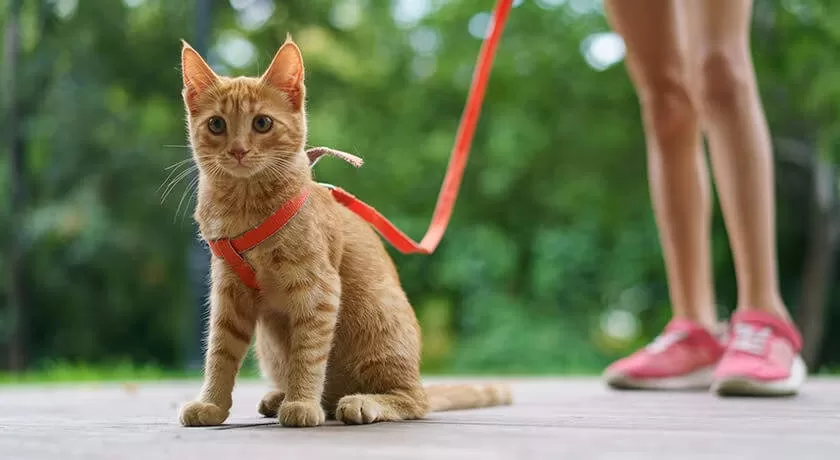
Remember to be patient with your cat during this process. Each feline has its own rhythm and style, and it’s important to respect that. Furthermore, don’t forget essential care during walks, such as keeping your cat close, ensuring its vaccinations are up to date and making regular visits to the vet to ensure its health and well-being.
By going out for a walk with your cat, you will be providing him with benefits, such as mental and physical stimulation, as well as strengthening the bond between you. Enjoy this moment together, ensuring safety, fun and a deeper connection with the world around you.
FAQ
Q: Is walking cats on a leash a challenging task?
A: Yes, felines don’t tend to like feeling restricted, which makes leash walking challenging.
Q: How do I get my cat used to wearing a collar?
A: It is possible to get your cat used to wearing a collar through training and patience. It’s important to start indoors, letting the feline become familiar with the accessory.
Q: How do I choose the right chest collar for my cat?
A: It is important to choose a cat-friendly chest collar that is comfortable and safe. The size and personality of the cat must be taken into account.
Q: How do I encourage my cat to walk on a leash?
A: It is possible to encourage your cat to walk on a leash indoors, allowing him to explore the environment at his own pace.
Q: What precautions should I take during my first trip outdoors?
A: It’s important to start slowly and allow your cat to explore the environment at its own pace during its first trip outside.
Q: How can I encourage my cat during walks?
A: Offering rewards and praise to your cat during walks is essential to encourage him to feel more comfortable and confident.
Q: Why is patience key when training your cat to wear a collar?
A: Each cat has its own rhythm and style, so patience is essential when training your cat to wear a collar.
Q: What essential precautions should I take during tours?
A: During walks, it is important to keep the cat close, ensure that it is up to date with its vaccinations and make regular visits to the veterinarian.
Q: What are the benefits of cat walks?
A: Walks bring happiness, encourage physical exercise and provide the cat with a greater connection with the external environment.
Source Links
- http://gatinhobranco.com/como-acostumar-seu-gato-a-passear-de-coleira/
- https://www.petz.com.br/blog/saude-e-cuidados/gato-na-coleira/
- https://pt.wikihow.com/Treinar-um-Gato-para-Andar-na-Coleira

